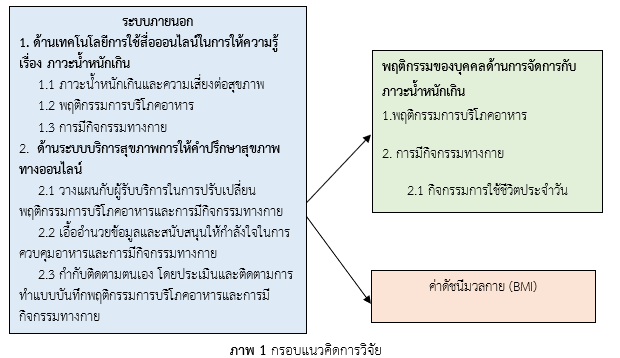ผลของการใช้สื่อวีดีทัศน์ร่วมกับการให้คำปรึกษาสุขภาพทางออนไลน์ต่อพฤติกรรมการบริโภคอาหารการมีกิจกรรมทางกาย และดัชนีมวลกายของสตรีวัยผู้ใหญ่ตอนต้นที่มีภาวะอ้วน
คำสำคัญ:
คำสำคัญ: สื่อ, คำปรึกษาทางออนไลน์, พฤติกรรมบริโภคอาหาร, การมีกิจกรรมทางกายและค่า ดัชนีมวลกายบทคัดย่อ
การวิจัยแบบกึ่งทดลองศึกษาในกลุ่มเดียวมีการวัดผลก่อนและหลังการทดลองนี้มีวัตถุประสงค์เพื่อศึกษาผลเปรียบเทียบค่าเฉลี่ยคะแนนพฤติกรรมการบริโภคอาหาร การมีกิจกรรมทางกายและค่าดัชนีมวลกายก่อนและหลังได้รับสื่อวีดีทัศน์ร่วมกับการให้คำปรึกษาทางสุขภาพออนไลน์และติดตามความคงอยู่ในระยะ 12 สัปดาห์ของสตรีวัยผู้ใหญ่ตอนต้นในเขตโรงพยาบาลส่งเสริมสุขภาพตำบลท่าเรือ คัดเลือกกลุ่มตัวอย่างโดยสุ่มตัวอย่างแบบง่ายได้จำนวน 27 คน ได้รับการใช้สื่อวีดีทัศน์ร่วมกับการให้คำปรึกษาสุขภาพทางออนไลน์ภายหลังการทดลองและติดตามความคงอยู่ในสัปดาห์ที่ 12 โดยใช้เครื่องมือ ดังนี้ 1) เครื่องมือแบบวัดพฤติกรรมการบริโภคอาหาร 2) เครื่องมือแบบวัดการมีกิจกรรมทางกาย นำมาตรวจสอบความตรงทางด้านเนื้อหาและวิเคราะห์ค่าดัชนีความสอดคล้องอยู่ระหว่าง 0.67 - 1.00 ตรวจสอบความเชื่อมั่นด้วยการหาค่าสัมประสิทธิ์แอลฟาของครอนบาคได้ค่าความเชื่อมั่นเท่ากับ .80 และ .82 ตามลำดับ วิเคราะห์ข้อมูลด้วยสถิติ Wilcoxon Signed Rank Test และ Freidman Test พบว่า
1. ค่าเฉลี่ยคะแนนพฤติกรรมการบริโภคอาหารหลังทดลองและติดตามความคงอยู่ในสัปดาห์ที่ 12 สูงกว่าก่อนทดลองอย่างมีนัยสำคัญทางสถิติที่ระดับ .001 (p-value < .001)
2. ค่าเฉลี่ยคะแนนการมีกิจกรรมทางกายหลังทดลองและติดตามความคงอยู่ในสัปดาห์ที่ 12 พบว่าสูงขึ้นกว่าก่อนทดลองอย่างมีนัยสำคัญทางสถิติที่ที่ระดับ .01 (p-value = .001)
3. ค่าดัชนีมวลกายระหว่างหลังการทดลองและความคงอยู่ในสัปดาห์ที่ 12 กับก่อนทดลองไม่แตกต่างกัน (p-value = .228)
จากผลการศึกษานี้ควรนำผลของการได้รับสื่อวีดิทัศน์ร่วมกับการให้คำปรึกษาสุขภาพทางออนไลน์นำไปใช้ได้ในโรงพยาบาลส่งเสริมสุขภาพส่วนตำบลในเชิงรุก เพื่อเป็นการปรับเปลี่ยนพฤติกรรมในการดูแลตนเองได้อย่างต่อเนื่อง ซึ่งเป็นการป้องกันที่จะทำให้เกิดปัญหาทางสุขภาพได้ในอนาคต
เอกสารอ้างอิง
Alkhulaifi, F., & Darkoh, C. (2022). Meal timing meal frequency and metabolic syndrome. Nutrients, 14(9), 1-10.
Bronfenbrenner, U. (1979). The ecology of human development: Experiments by nature and design. Harvard University Press google schola, 2, 139-163.
Chansem, W., & Jubchi, P. (2008). The Development of Types of Appropriately Exercise for Overweight Persons: Research Report. Institute of Physical Education. (in Thai)
Department of Health, Ministry of Public Health. (2021). Percentage of The Working Age Population Aged 18-59 years with A Normal Waist Circumference at The District Level. Health [online]. Retrieved December 7, 2022 from http://dashboard.anamai.moph.go.th/dashboard/waist1859/index?year=2021. (in Thai)
Hollander, M., Wolfe, D. A., & Chicken, E. (2013). Nonparametric Statistical Methods. John Wiley & Sons.
Leartwanawattana, J., Sukkum, W., Sumrit, W., & Sanee, N. (2021). Effects of rubber chain exercises and dietary control on overweight female adults. Journal Of Southern Technology, 14(1), 112–121. (in Thai)
Lim, J. U., Lee, J. H., Kim, J. S., Hwang, Y. I., Kim, T. H., Lim, S. Y. et al. (2017). Comparison of world health organization and asia-pacific body mass index classifications in COPD patients. International Journal of Chronic Obstructive Pulmonary Disease, 12, 2465–2475.
Manosaksaree, T. (2016). Effectiveness of weekly self-weighing frequency associated with reduced weight and behavioral change. BMJ. 3(1), 11-12. (in Thai)
Palapol, T., Suwonaroop N., & Ruangjiratain, S. (2017). The effect of enhancing perceived self-efficacy program on food consumption and exercise behavior adults at risk for metabolic syndrome. Journal of Nursing Science Chulalongkorn University, 29(1), 81-91. (in Thai)
Phopa, Y., & Pummarak, S. (2023). The effect of self-efficacy promotion program on weight loss of obese late adolescents. Christian University Journa, 29(1), 80-93. (in Thai)
Pinchaleaw, D. (2018). The management of the obesity for community nurses practitioner. Journal of the Police Nurses, 10(2), 433–441. (in Thai)
Polit, D.F., & Beck, C.T. (2008). Nursing Research: Generating and Assessing Evidence for Nursing Practice 8th ed. New York, NY: Lippincott William & Wikins.
Sasang, U., Krongyuth, S., & Chananin, Y. (2022). Factors associated with self-care behaviors of patients with non-communicable diseases. Journal of Nursing and Education, 15(1), 45-58. (in Thai)
Senee, A., Kamthong, S., & promsila, W. (2023). Effects of health promotion for life behaviors modification program on practical behaviors, body mass index, and blood pressure levels among high-risk hypertensive person. Journal of MCU Nakhondhat, 10(4), 55-70. (in Thai)
Sindhu, S., Limruangrong, P., & Tankhampuan, T. (2021). Nurse Led in Overweight Management: Nurse Led in Overweight Management. Bangkok: Watthana Publishing. (in Thai)
Tharua Subdistrict. (2023). Retrieved September25, 2023 from http://www.tharua-sao.go.th/ general3.php. (in Thai)
Tuphanich W., Tiappho J., & Lammana D. (2022). Challenges faced by community nurses in managing obesity in adults. Charoenkrung Pracharak Hospital Journal, 18(1), 99–114. (in Thai)
Wisapha, C., Wiroonpanich, W., & Wattanasit, P. (2022). Effects of weight control mobile application onfood consumption behavior, physical activity, and body weight in overweight adolescents. Journal of the Police Nurses, 12(1), 73-85. (in Thai)
WorldObesity Federation. (2023). World Obesity Atlas 2023. Retrieved June27, 2024 from https://data.worldobesity.org/publications/?cat=19

ดาวน์โหลด
เผยแพร่แล้ว
ฉบับ
ประเภทบทความ
สัญญาอนุญาต
ลิขสิทธิ์ (c) 2024 วารสารการพยาบาลและการศึกษา

อนุญาตภายใต้เงื่อนไข Creative Commons Attribution-NonCommercial-NoDerivatives 4.0 International License.





